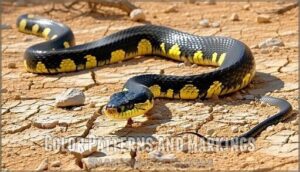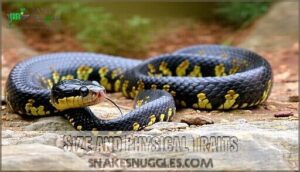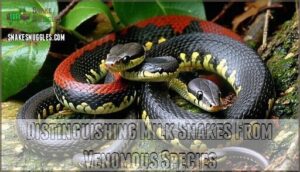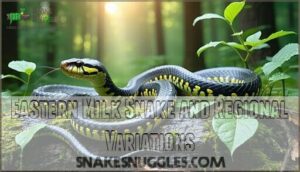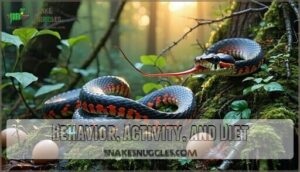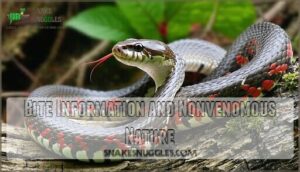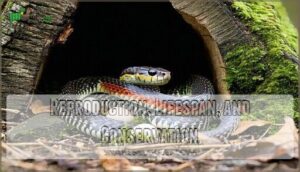This site is supported by our readers. We may earn a commission, at no cost to you, if you purchase through links.
 Milk snakes are completely harmless, nonvenomous constrictors that rarely bite humans. These striking serpents display red, black, and white banded patterns with smooth, glossy scales and a distinctive Y-shaped head marking.
Milk snakes are completely harmless, nonvenomous constrictors that rarely bite humans. These striking serpents display red, black, and white banded patterns with smooth, glossy scales and a distinctive Y-shaped head marking.
They’re nocturnal hunters that constrict rodents, birds, and eggs across diverse habitats from Canada to Central America. When threatened, they’ll mimic dangerous coral snakes through coloration and may rattle their tails like rattlesnakes.
Their defensive behaviors include hissing and coiling, but they prefer fleeing over fighting. These beneficial pest controllers pose no threat to you or your pets, making them valuable ecosystem allies.
Table Of Contents
- Key Takeaways
- Milk Snake Identification and Appearance
- Habitat, Range, and Distribution
- Behavior, Activity, and Diet
- Bite Information and Nonvenomous Nature
- Reproduction, Lifespan, and Conservation
- Frequently Asked Questions (FAQs)
- What is the scientific name for milk snakes?
- Where are Sinaloan milk snakes primarily found?
- What is the average lifespan of a milk snake in captivity?
- What type of eggs do milk snakes lay?
- How do milk snakes subdue their prey?
- Can milk snakes make good pets?
- How long do milk snakes live?
- Are milk snakes good for pest control?
- Do milk snakes shed their skin regularly?
- What temperatures do milk snakes need?
- Conclusion
Key Takeaways
- You can safely handle milk snakes – They’re completely nonvenomous constrictors that rarely bite humans and pose no threat to you or your pets, making them beneficial allies for natural pest control around your property.
- You’ll recognize them by their distinctive banded pattern – Look for red, black, and white/yellow rings with smooth, glossy scales and a Y-shaped marking on their head, remembering "red touches black, friend of Jack" to distinguish them from dangerous coral snakes.
- They’re nocturnal hunters that control rodent populations – These secretive serpents actively hunt mice, rats, birds, and eggs at night using constriction methods, making them valuable for keeping pest numbers down naturally.
- You can find them across diverse habitats throughout the Americas – From southeastern Canada to Central America, they’ve adapted to live in woodlands, rocky areas, agricultural fields, and even human structures like barns and outbuildings.
Milk Snake Identification and Appearance
When you encounter a milk snake in the wild, you’ll notice their distinctive banded pattern of red, black, and white or yellow rings that often causes confusion with venomous coral snakes.
Those striking red, black, and yellow bands make milk snakes nature’s ultimate mimics
You can identify these nonvenomous colubrids by their smooth, glossy scales and the characteristic light-colored Y or V marking that points toward their tail on the back of their head.
Color Patterns and Markings
Spotting milk snakes becomes easier when you understand their distinctive banding. These serpents display notable color morphs and pattern variations that serve as nature’s warning system through Batesian mimicry.
- Blotched bands: Red, black, and white/yellow bands create striking scale shades
- Checkerboard pattern: Black-and-white belly markings distinguish them from coral snakes
- Color variations: Light Y-shaped neck markings point toward the tail
- Marking genetics: Subspecies exhibit different banding intensities and arrangements
Understanding the role of milk snake colors is essential in identifying these species.
Remember: "Red touches black, friend of Jack" helps identify these harmless mimics.
Size and Physical Traits
Milk snakes (Lampropeltis triangulum) reach 14 to 69 inches in body length, with Central and South American subspecies growing largest.
You’ll notice their smooth snake scales create a glossy appearance, while scale patterns include 19-23 dorsal scale rows.
Growth rates vary among color morphs, but all maintain round pupils and consistent snake characteristics regardless of size.
Distinguishing Milk Snakes From Venomous Species
Distinguishing between milk snakes and their venomous lookalikes requires careful observation of key features. Milk snakes display red bands touching black bands, while coral snakes show red touching yellow. Copperheads lack the distinct banded pattern entirely, featuring hourglass-shaped crossbands instead.
These mimicry tactics help harmless milk snakes survive by fooling predators through species differentiation based on color pattern recognition.
Habitat, Range, and Distribution
You’ll find milk snakes across an impressive range spanning from southeastern Canada through Central America, with Lampropeltis triangulum adapting to diverse environments from woodlands to rocky hillsides.
These adaptable serpents thrive in habitats ranging from natural forests and wetland borders to human-modified landscapes like barns and outbuildings.
Natural Habitats and Adaptability
You’ll find milk snakes thriving in remarkably diverse environments across their range. These adaptable serpents demonstrate outstanding Environmental Adaptation, occupying various Milk Snake Habitat types from forest edges to agricultural fields.
Their Habitat Diversity includes:
- Woodlands and forest edges with abundant cover
- Rocky hillsides and outcroppings providing shelter
- Agricultural fields offering rodent prey sources
- Wetland borders with diverse food opportunities
- Human structures like barns and outbuildings
This adaptability reflects their broad Ecosystem Roles and varied Wildlife Interactions.
Geographic Range in The Americas
You’ll find milk snakes across an impressive Continental Spread, from southeastern Canada down through Central America. These Lampropeltis species showcase notable Geographic Variations throughout American Habitats.
Their South American Distribution extends into northern regions, while North American populations thrive from Kentucky’s forests to Mexico’s deserts. This adaptability across diverse Regional Adaptations makes milk snakes one of the continent’s most widespread Snake Habitat specialists.
Eastern Milk Snake and Regional Variations
You’ll discover fascinating geographic isolation effects across Lampropeltis triangulum populations. Eastern Milksnake subspecies classification reveals distinct regional coloration patterns, from blotched mountain forms to banded southeastern varieties.
Geographic isolation creates unique snake morphs, with western populations showing orange heads while eastern forms display classic "Y" markings. Species variation in Lampropeltis demonstrates notable adaptability, producing diverse milksnake appearances that improve local predator mimicry effectiveness.
The Eastern Milksnakes’ snake habitat range plays a vital role in their distribution and behavior.
Behavior, Activity, and Diet
You’ll discover that milk snakes (Lampropeltis triangulum) are primarily nocturnal hunters who spend daylight hours hiding under rocks, logs, or in burrows.
These secretive serpents use their forked tongues to detect chemical trails from prey, which includes rodents, birds, eggs, and even other snakes that they constrict before swallowing whole.
Nocturnal and Secretive Behaviors
Understanding milk snake behavior means accepting they’re stealth masters. These nocturnal serpents prefer operating under darkness’s cover, using their cryptic behavior to avoid detection. You’ll rarely spot eastern milksnakes during daylight hours since they maintain secretive lifestyles.
Their nighttime hunting strategy involves three key elements:
- Moving silently through leaf litter and underbrush
- Using chemical detection via tongue-flicking to locate prey
- Remaining motionless until striking opportunities arise
This stealth mode maximizes hunting success while minimizing predator encounters.
Brumation and Seasonal Activity
During winter months, you’ll find milk snakes entering brumation, their version of hibernation. Eastern milksnakes seek communal winter denning sites like rock crevices or burrows for cold weather adaptation.
These dormancy periods last several months, with brumation patterns varying by region. Seasonal migration to suitable dens ensures survival through harsh conditions.
Understanding proper snake brumation care is essential for the health and wellbeing of pet snakes during this period.
Diet and Hunting Techniques
Like natural pest control agents, milk snakes hunt using complex strategies. They detect food sources through tongue-flicking, collecting scent particles for prey selection. These nocturnal predators employ both ambush tactics and active hunting.
- Constriction methods: Larger prey gets squeezed before swallowing
- Hunting strategies: Mix of stalking and opportunistic strikes
- Prey selection: Rodents, birds, eggs, and smaller snakes
This milksnake behavior makes them valuable for natural rodent control. Understanding their snake food preferences is essential for their care and management.
Bite Information and Nonvenomous Nature
You’ll be relieved to know that milk snakes (Lampropeltis triangulum) are completely nonvenomous and pose no serious threat to humans or pets. While these kingsnakes can bite when threatened, their small teeth usually cause only minor puncture wounds similar to a cat scratch.
Do Milk Snakes Bite?
Most Milk Snakes rarely bite humans, preferring flight over fight when threatened. These Nonvenomous Snakes deliver harmless bites causing minor discomfort, unlike Venomous Snakes. Bite Symptoms include slight punctures requiring basic Bite Treatment with soap and water.
Understanding Snake Behavior helps prevent Defensive Mechanisms activation. Milksnake bites pose no serious health risks to humans or pets. The milk snake’s defense mechanisms, including mimicry of venomous snake behaviors, are fascinating to study.
Defensive Behaviors and Mimicry
When threatened, you’ll witness milk snakes perform impressive defensive behaviors and mimicry. These clever serpents employ color mimicry as their primary predator deterrent, resembling dangerous coral snakes through their banded patterns. Their defensive posturing includes threat display behaviors like coiling and vibrational warning through tail rattling against debris.
- Animal Mimicry: Milk snakes mimic venomous snakes’ appearance, confusing potential predators.
- Threat Display: They flatten their bodies, hiss loudly, and strike defensively when cornered.
- Vibrational Warning: Tail vibration creates rattling sounds similar to rattlesnakes for snake identification confusion.
Milk snakes also exhibit snake defense mechanisms to protect themselves from predators.
Safety Around Humans and Pets
You’ll find milk snakes pose minimal risk to humans and pets. These nonvenomous constrictors rarely bite defensively, preferring to flee when threatened. Their mimicry of venomous copperheads actually protects both species through mistaken identity.
| Safety Factor | Milk Snake | Venomous Lookalike |
|---|---|---|
| Bite Danger | Harmless scratches | Potentially fatal |
| Aggression Level | Extremely docile | Defensive when cornered |
| Pet Interaction | Generally safe | Avoid completely |
| Human Encounters | Retreat quickly | May stand ground |
| Identification Key | Red touches black | Red touches yellow |
Practice proper snake identification and maintain respectful distance during wild snake interactions.
Reproduction, Lifespan, and Conservation
You’ll find that Lampropeltis triangulum follows fascinating reproductive patterns, with mating occurring in May and females depositing 3-24 eggs in protected locations during summer months.
These hardy serpents aren’t currently threatened, though some states monitor local populations as species of concern due to habitat changes.
Mating and Egg Laying Habits
During spring, milk snakes (Lampropeltis triangulum triangulum) enter their breeding season around May. These oviparous snakes engage in mating rituals before female reproduction begins. After successful mating, females seek suitable nesting locations for egg incubation.
Here are five key aspects of milksnake reproduction:
- Breeding timing – Lampropeltis species usually mate in late spring when temperatures warm
- Egg laying period – Females deposit 3-24 eggs during June and July
- Nesting site selection – Eggs are placed under rocks, debris, or in rotting vegetation
- Incubation duration – Eggs develop for approximately 60-80 days in warm conditions
- Multiple clutches – Some females may produce second clutches in favorable years
Hatchling Appearance and Development
After 60-75 days of egg incubation, tiny Lampropeltis triangulum triangulum hatchlings emerge with striking banded patterns already visible. These oviparous neonates measure 6-8 inches long and display identical neonate morphology to adults, just miniaturized.
You’ll notice their developmental stages progress rapidly through juvenile growth phases, with hatchling care being minimal since they’re born ready to hunt independently. Proper ball python care is essential for their growth and development.
Conservation Status and Wildlife Protection
While adult milk snakes develop into beautiful reptiles, you’ll be relieved to know they’re not facing extinction. The IUCN lists milk snakes as Least Concern globally, though habitat loss threatens local populations. Wildlife Laws protect them in several states, and Conservation Efforts focus on Habitat Preservation and Species Research to maintain ecosystem balance. Effective snake conservation methods are essential for their survival.
- Eastern Milksnake Habitat receives special protection in Ontario and several U.S. states
- Reptile Conservation programs monitor populations through mark-recapture studies and radiotelemetry
- Wildlife Protection initiatives combat human persecution through educational campaigns
- Endangered Lists may include regional subspecies like Montana’s pale milk snake as "species of concern
Frequently Asked Questions (FAQs)
What is the scientific name for milk snakes?
Like a biological passport, you’ll recognize milk snakes by their scientific name Lampropeltis triangulum. This taxonomic label belongs to the kingsnake genus, with "triangulum" referencing their distinctive triangular head markings that help field researchers identify these harmless constrictors.
Where are Sinaloan milk snakes primarily found?
You’ll find Sinaloan milk snakes in southwestern Mexico, specifically inhabiting the dry, arid semi-desert regions of Sonora, Sinaloa, and southwestern Chihuahua states, where they rest beneath rocks and cactus plants.
What is the average lifespan of a milk snake in captivity?
Ever wondered how long you’ll be sharing your space with Lampropeltis triangulum?
Your captive milk snake usually lives 15-22 years, giving you plenty of time to appreciate these fascinating constrictors’ glossy beauty and nocturnal adventures.
What type of eggs do milk snakes lay?
Milk snakes lay leathery, oblong eggs rather than hard-shelled ones like birds.
You’ll find females depositing 3-24 eggs in June and July under rocks, debris, or in rotting vegetation after mating in May.
How do milk snakes subdue their prey?
You’ll see these constrictors wrap around their prey like a living vice. They squeeze until their victim can’t breathe, then swallow it whole headfirst.
This hunting strategy works perfectly for rodents, birds, and other snakes.
Can milk snakes make good pets?
Beauty lies in the eye of the beholder – you’ll find Lampropeltis triangulum makes excellent captive companions. They’re docile, easily bred, and adapt well to terrarium life with proper care.
How long do milk snakes live?
Captive milk snakes usually live 15-22 years, while their wild counterparts reach 10-20 years. You’ll find these hardy serpents mature around three years old, making them long-term companions that’ll share plenty of adventures.
Are milk snakes good for pest control?
Yes, you’ll find milk snakes excellent for pest control. They actively hunt rodents, making them natural allies against mice and rats around barns and homes. Their nocturnal hunting effectively reduces pest populations.
Do milk snakes shed their skin regularly?
Like clockwork, you’ll notice milk snakes shed their skin every 4-8 weeks as juveniles and every 2-4 months as adults. This natural process, called ecdysis, helps them grow and removes parasites.
What temperatures do milk snakes need?
You’ll need a temperature gradient with lows in the mid 70s and a basking spot of 85-90 degrees Fahrenheit.
This setup lets your milk snake thermoregulate properly throughout the day and night.
Conclusion
Milk snakes wear their vibrant bands as both shield and sword against predators, much like nature’s perfect costume party. These extraordinary constrictors are gentle giants of the serpent world, despite their intimidating appearance.
You’ve discovered that milk snakes facts bite information and pictures reveal their unique traits. They’re masters of deception, mimicking dangerous species while remaining completely harmless to humans.
Their nocturnal hunting prowess and pest-control abilities make them invaluable ecosystem partners. Milk snakes are worth protecting and appreciating, but always from respectful distances.
- https://ontarionature.org/programs/community-science/reptile-amphibian-atlas/milksnake/
- https://animaldiversity.org/accounts/Lampropeltis_triangulum/
- https://www.mass.gov/info-details/learn-about-milksnakes
- https://fieldguide.wildlife.utah.gov/?Species=Lampropeltis+triangulum
- https://animalia.bio/milk-snake

